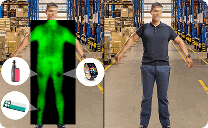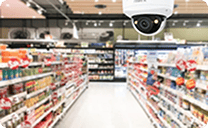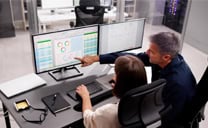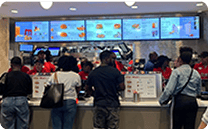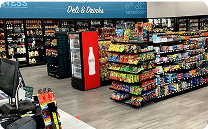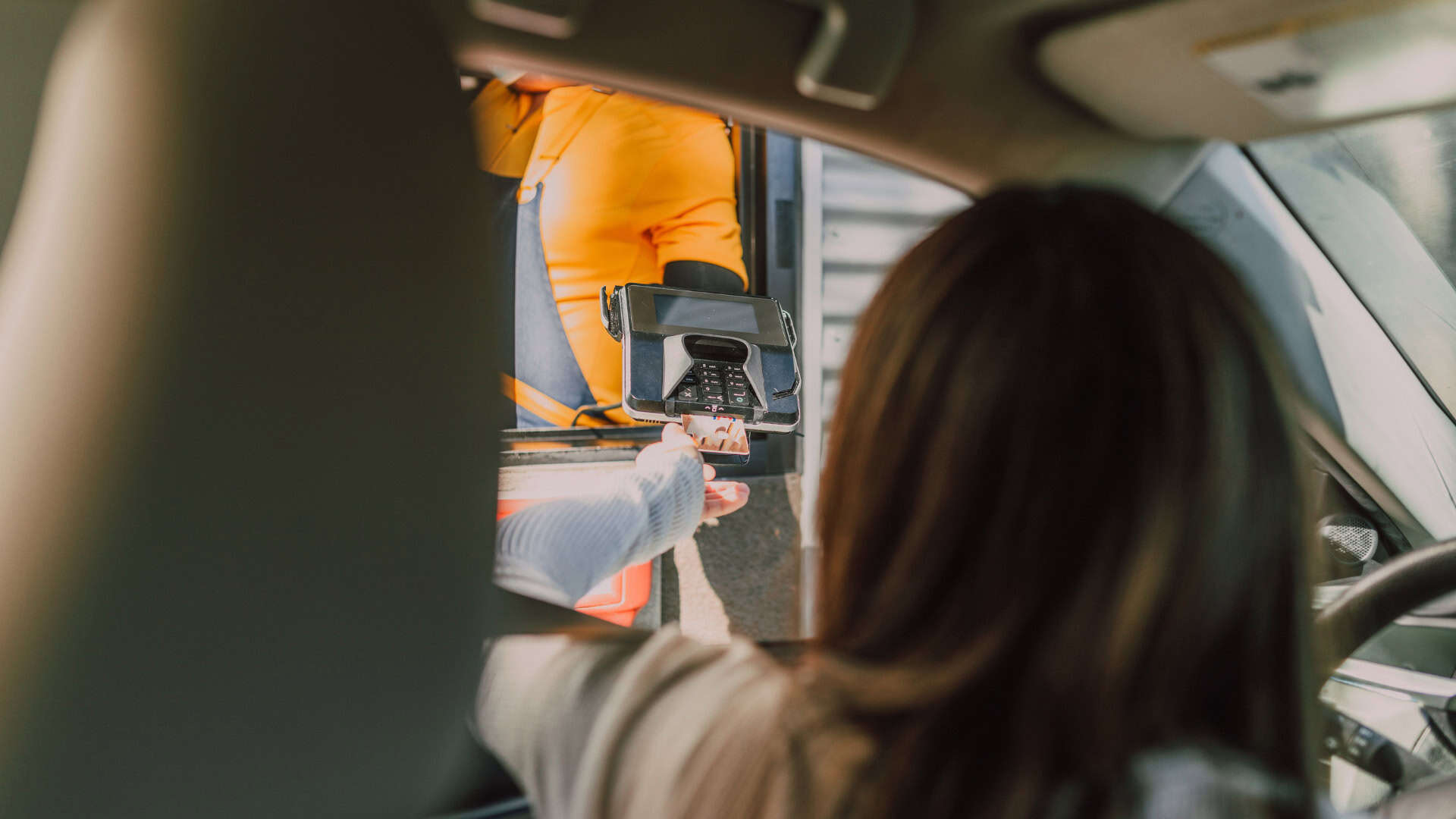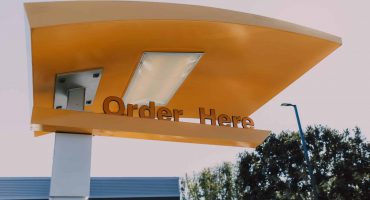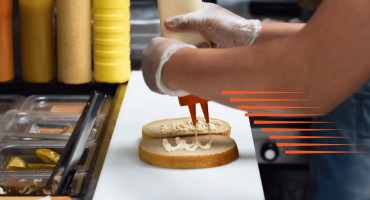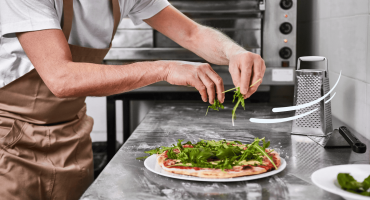In This article
As with any business, QSR restaurants’ primary goals are maximizing revenue potential and profitability. To achieve those objectives, owners and managers must know how to improve drive-thru speed of service. The formula is relatively straightforward: The faster the service, the more orders are completed in less time. QSR Magazine says, “Digital ordering and delivery has grown 300 percent faster than dine-in traffic since 2014.” The Hustle/HubSpot Media reported in February 2025 that research firm Circana estimates that 43% of all fast-food orders are via the drive-thru, totaling $140 billion annually.
QSR restaurants and their drive-thru customers want a fast-ordering process without damaging the brand, customer service, and satisfaction. Intouch Insights reports in its 2024 Drive-Thru Study that “based on an average meal cost of $11.05, if brands were to improve their total time by even 5 seconds, then the potential gain per year per store unit would be $9,531.953.”
Key Challenges Affecting Drive-Thru Speed
Learning how to improve drive-thru speed of service requires understanding the key challenges that cause slow drive-thru service and potentially lost customers and revenues. Operational bottlenecks are typically the common challenges that can negatively affect drive-thru speed and service. The overall strategy is to improve restaurant workflow at all service stations.
- Order-taking inefficiencies – Various factors in the ordering process can increase customers’ wait times, including poor signage, a single customer lane during peak hours, mistakes while rushing orders, and loss of tech tools.
- Kitchen workflow—Poorly managed, understaffed, and unprepared for peak ordering are all obstacles to improving drive-thru speed. Kitchens may be working with outdated equipment/technology and need more automation.
- Payment processing delays—QSRs that don’t offer order-ahead and cashless payment options will provide slow service. Employees who aren’t sufficiently trained in handling cash can also create delays.
- Insufficient staff and training – Failing to manage staff scheduling to cover peak hours and absences will result in insufficient staff for the ordering/preparation process. Inadequate training can lead to any of the inefficiencies in the restaurant workflow listed above and to above-average staff turnover.
Optimizing Order-Taking Processes
When QSR owners and managers ask how to improve drive-thru speed of service, the first answer is to analyze their current drive-thru process from a customer’s perspective. Understanding their experience from when they drive onto the property through order delivery will reveal the solutions to a slow order-taking process.
- Exterior presentation—The position and accuracy of signage and menu boards are where to start, and multiple lanes for simultaneous ordering will reduce customers’ perceived wait times.
- AI-powered voice ordering systems—These ordering systems convert a customer’s spoken order into digital text for the kitchen. When these systems are integrated with the restaurant’s POS system, even more efficiencies and increased drive-thru speed are achieved.
- Mobile pre-orders and app integration—This solution is for any QSR that wants to improve its drive-thru speed. According to the Ipsos 2024 QSR/Fast Casual Digital Ordering Performance Study, 65% of surveyed consumers said they had used an order-ahead app.
- Dedicated staff for order accuracy—Training groups of staff for specific job roles (order-taking, order processing, and order preparation) can improve the overall efficiency of the drive-thru and restaurant workflow.
Improving Kitchen Workflow and Food Preparation
The order-taking action occurs in the drive-thru, but the order preparation action is in the kitchen. Managers must tightly coordinate the drive-thru and kitchen processes to maintain optimal restaurant workflow. If QSR managers overlook kitchen operations, they risk disrupting synchronization between the two areas, which makes it difficult to improve fast food order accuracy.
- Evaluate the kitchen layout – With designated food preparation workstations, careful placement of equipment, and role-playing staff training, a QSR kitchen will operate more efficiently and not become an obstacle during peak hours.
- Standardization – Standardizing recipes, preparation methods, and cooking techniques can improve drive-thru speed and order accuracy.
- Advance prepping—Some menu items can be prepared in advance, streamlining the entire preparation process and moving orders through it faster.
- Kitchen Display Systems (KDS) – Paper tickets are the past in drive-thru order processing. Digital displays are a requirement in any modern QSR kitchen to remain competitive and process more orders in less time.
- Other tech tools—Automated technology, such as burger-flipping machines, has advanced quickly and is a kitchen streamlining solution. The newest POS systems have multiple features and functions to increase transaction speed.
Enhancing Payment and Checkout Processes
To know how to improve drive-thru speed of service, QSR owners and managers should thoroughly evaluate their payment and checkout processes to identify any inefficiencies or even signs of employee credit card fraud. With that evaluation in hand, management can implement several strategies:
- Self-ordering kiosks—Most QSR customers are familiar with using a drive-thru kiosk or menu board to order. The option to pay independently without interacting with staff improves wait time and reduces staff tasks.
- Contactless payment—Many customers who pay for their orders independently are comfortable with contactless payment systems. These systems free drive-thru personnel from handling debit and credit cards and cash, allowing them to focus on better customer service.
- Mobile app for pre-orders—A mobile app is an essential component of the ordering process at any QSR restaurant. The same Ipsos survey/report cited above found that 90% of adults aged 18–24 said they have used a QSR order-ahead app.
- Dedicated payment-processing staff – Assigning dedicated staff to specific tasks, such as the payment process, especially during peak hours, benefits the drive-thru process.
Leveraging Technology for Speed Optimization
Although investing in technologies at QSR restaurants must be planned carefully, leveraging many of those technologies is an essential business strategy to increase the speed of drive-thru service and order accuracy. Not only are those technologies a competitive necessity, but they also signal to employees (mostly young and tech/digital savvy) that the company is interested in making their jobs easier.
- AI as an order management tool – While AI enhances the drive-thru ordering process for customers, it is also a powerful management tool. By analyzing customer behavior and traffic patterns, managers learn where to make improvements and remove bottlenecks.
- Real-time predictive analysis—Today’s advanced technologies can also deliver vehicle counts, wait times, and other data in real time, giving managers more insights into the drive-thru process and allowing them to adjust operations accordingly.
- AI-powered menu recommendations—With AI predictive analysis, digital menu boards can offer menu recommendations, helping customers make order decisions quicker. Boards can also change those recommendations as the pace of orders and preparation time demand.
- Advanced CCTV cameras – CCTV cameras are now enhanced with AI to improve security (facial recognition). Analyzing video data provides managers with another method to identify where they can improve speed of service.
Employee Training and Performance Management
Investing in various technologies can streamline and improve the ordering/food preparation process, but comprehensive fast food employee training is an essential strategy. Integrating the human element into these processes and helping employees develop new skills is a vital answer to the question of how to improve drive-thru speed of service. Training modules can include:
- Continuous speed and efficiency training—Understanding the concepts behind increasing speed of service and improving efficiency is not enough. Employees also need hands-on, role-playing exercises to familiarize themselves with the equipment and tech tools and “program” their hands, eyes, and brain coordination to spend the least time on every ordering step.
- Cross-training—Although assigning staff to work the same position or station in the ordering process is an efficiency strategy, they must be able to seamlessly step into other roles to fill gaps or respond to heavy traffic.
- Key Performance Indicators (KPIs) – Speed of service, order accuracy, and restaurant workflow are improved when management sets KPIs for the entire staff, segmented groups, and individual employees. These may include attendance, service time, customer satisfaction, error rates, and others specific to the kitchen staff and employees handling transactions.
Managing Peak Hour Traffic and Bottlenecks
Like all restaurants, QSRs have regular peak-hour traffic, depending on their menu selection. Early morning, lunchtime, and evening are the standard rush periods. Employees and technology may be working efficiently, but management’s role is managing people, technology, and a kitchen. Managers must also be able to identify and eliminate bottlenecks in the fast-paced atmosphere during peak hours.
- Precise employee scheduling—Managers need a plan and a pre-arranged schedule for adding more staff to deal with peak traffic. This could mean moving employees in real time to other positions or having employees on call who can arrive quickly.
- Lane directors – QSRs can improve drive-thru speed by assigning employees as lane directors (welcomers/concierge). These team members guide drivers, assist customers with automated menu boards, and answer questions before they reach the window. Lane directors also monitor traffic flow, identify bottlenecks, and inform management to make quick adjustments.
- Inventory management software – Advanced software tools can enhance inventory control and movement, predict when the kitchen needs more items based on the menu and time of day, and minimize waste.
- Preparation during off-peak hours—Between peak traffic periods, QSR managers and staff have an excellent opportunity to prepare for the next order rush. Cleaning the staff/customer interface area, restocking food items in the kitchen, and conducting immediate training are all good uses of the lull.
Customer Experience and Speed Balance
QSR customers want fast food order accuracy, and so do QSR owners, because it directly impacts maximizing orders, revenues, and profits. Customers also expect quality service, and owners want to deliver it. Striking the balance between the two (fast, accurate orders and quality service) often separates successful QSR operations from mediocre ones.
- Order accuracy and improved speed – Management can achieve both goals by smoothly integrating staff and technology and providing proper training. These strategies help ensure fast food order accuracy while maintaining efficiency.
- Friendly, but fast customer interactions – Excellent customer service requires friendly interactions between employees and customers, but employees must know how to keep those conversations short. Employee training focused on interactive skills is how to achieve this critical balance.
- Real-time wait times update – Automated systems and apps can inform QSR customers how long they’ll wait and why. Employees, with access to real-time order data through advanced technologies, can relay that information directly to customers and manage expectations effectively.
Conclusion
QSR owners and managers are always eager to learn how to improve drive-thru speed of service. Fast, accurate orders of quality food with friendly customer service are the fundamental promise all QSR restaurants have made to their customers. Without delivering on that promise, QSR ownership and management will find it challenging to remain competitive and maximize revenues and profits. The solutions for faster order processing and improved restaurant workflow are readily available, from AI-powered voice ordering systems to mobile apps for pre-ordering to a Kitchen Display System for efficient order fulfillment.
A full array of technologies can increase the speed of the ordering process, including payment and checkout. Automated menu boards/ordering systems, contactless payments, and predictive data analysis of order speed, error rates, wait times, and performance parameters can give managers valuable insights. Fast food employee training must be comprehensive and continuous to maintain KPIs and deliver a customer experience that maximizes return trips and ticket totals. To learn more about our drive-thru and speed of service solutions for QSR, visit our website.
Frequently Asked Questions
Q: How to improve drive-thru speed of service at QSR restaurants?
A: QSR owners can improve drive-thru service with a multi-tiered strategy that identifies the key challenges affecting drive-thru speed and common operational bottlenecks and implements various solutions for greater performance and profitability. The primary strategies include advanced technologies for customer ordering, kitchen preparation, payment systems, and predictive data analysis, and comprehensive employee training so they are prepared for their crucial roles.
Q: What are the key challenges affecting drive-thru speed of service?
A: Because any QSR ordering system has many moving parts that must be well coordinated, operational bottlenecks can appear quickly and disrupt the entire process. These bottlenecks include order-taking and kitchen inefficiencies, payment process delays, staffing shortages, etc. Management must have plans and strategies to address and quickly open bottlenecks, and employees need specific training to improve immediate restaurant workflow.
Q: What technologies are best suited to improve drive-thru speed of service?
A: Artificial intelligence (AI) is quickly becoming an integral part of much of the equipment and steps in the ordering process. From AI-powered voice ordering systems and AI-generated menu recommendations to real-time wait time tracking, AI is giving QSR owners new and innovative methods to reach many performance goals. AI is also an important feature of CCTV cameras and other security systems to minimize theft, employee fraud, and inventory irregularities.
Q: Why does fast food employee training lead to smoother drive-thru operations?
A: The work of QSR employees is the fuel that drives drive-thru and kitchen operations. Thorough training prepares them to provide fast, accurate ordering and food preparation, creating a reputation for outstanding customer service. That training should include using technology efficiently, teaching employees to work more than one role or position as conditions require, and embracing their KPIs to understand where they need improvement.
